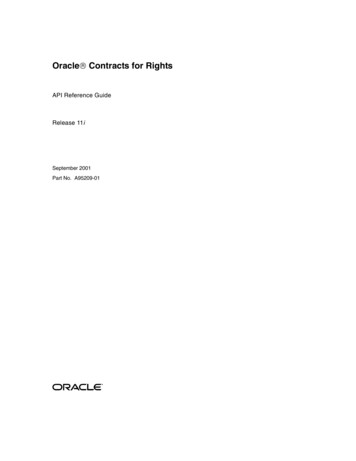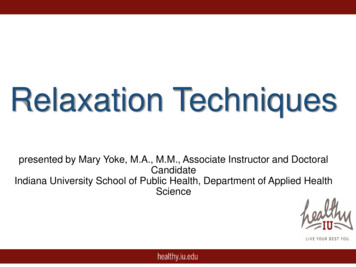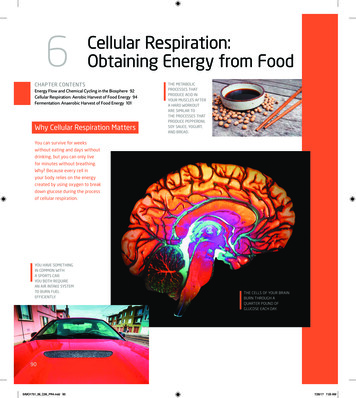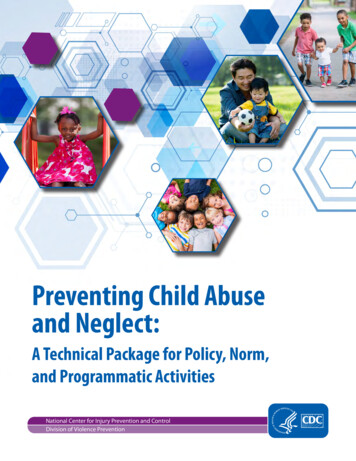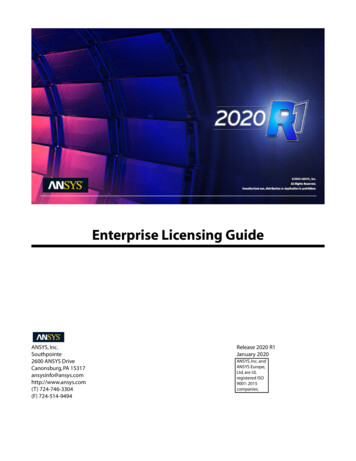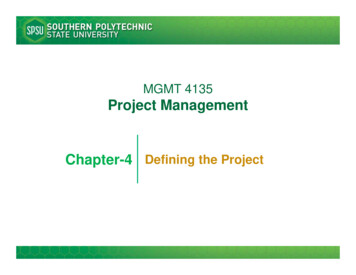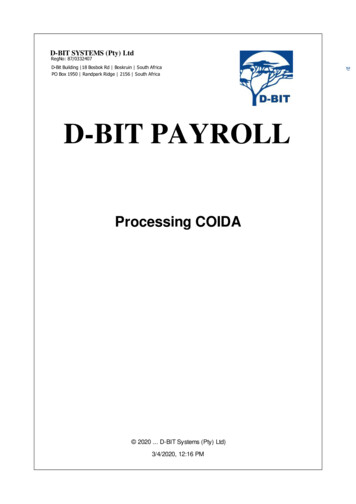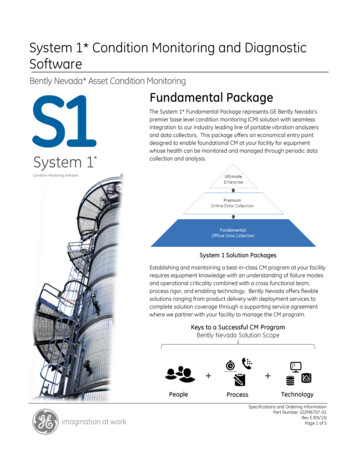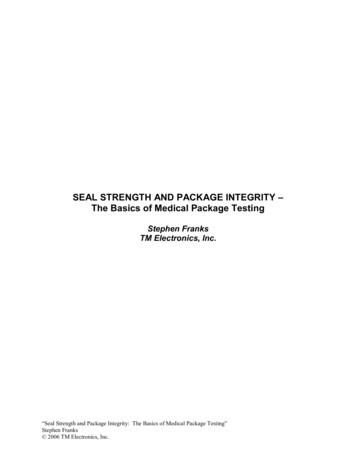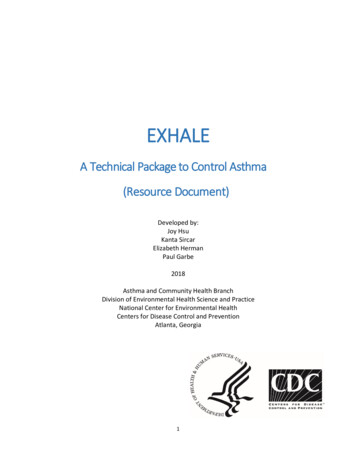
Transcription
EXHALEA Technical Package to Control Asthma(Resource Document)Developed by:Joy HsuKanta SircarElizabeth HermanPaul Garbe2018Asthma and Community Health BranchDivision of Environmental Health Science and PracticeNational Center for Environmental HealthCenters for Disease Control and PreventionAtlanta, Georgia1
Centers for Disease Control and PreventionAnne Schuchat, MD (RADM, USPHS), Acting DirectorNational Center for Environmental HealthPatrick Breysse, PhD, MHS, DirectorDivision of Environmental Health Science and PracticeJohn Decker, MS, RPh, CIH, Acting DirectorSuggested citation:Hsu J, Sircar K, Herman E, Garbe P. (2018). EXHALE: A Technical Package to Control Asthma. Atlanta,GA: National Center for Environmental Health, Centers for Disease Control and Prevention.2
Table of ContentsAcknowledgements . 4External Reviewers . 5Executive Summary . 6Overview of EXHALE . 8Education on Asthma Self-Management . 13X-tinguishing Smoking and Secondhand Smoke . 15Home Visits for Trigger Reduction and Asthma Self-Management Education . 17Achievement of Guidelines-Based Medical Management . 20Linkages and Coordination of Care Across Settings. 23Environmental Policies or Best Practices to Reduce Asthma Triggers from Indoor, Outdoor, andOccupational Sources . 26Part 1: Indoor Sources of Asthma Triggers . 26Part 2: Outdoor Sources of Asthma Triggers . 28Part 3: Occupational Sources of Asthma Triggers. 29Sector Involvement . 31Monitoring and Evaluation . 34Conclusion . 36List of Abbreviations . 37Appendix: Summary of Strategies and Approaches of EXHALE . 38References . 433
AcknowledgementsWe would like to thank the following individuals who contributed to the development of this technicalpackage. We thank leadership from the Centers for Disease Control and Prevention (CDC), the NationalCenter for Environmental Health, the Division of Environmental Hazards and Health Effects, and the AirPollution and Respiratory Health Branch, as well as state colleagues from the CDC National AsthmaControl Program, for their careful review and helpful feedback on earlier iterations of this document.We thank the following individuals for their contributions to this technical package (individuals arelisted with their affiliations when they contributed to this document): National Center for Environmental Health, CDC: Cathy Bailey, Sheri Barrera Disler, Suzanne Beavers,Matthew Blum, Dan Burrows, Ginger Chew, Pamela Collins, Scott Damon, Shirl Ellis Odem,Tchernavia Gregory, Tyiesha Johnson, Robin Kuwahara, Anne Meyers, Maria Mirabelli, AyanaPerkins, Jeremy Sarnat, Dorothy Stearns, Kathryn Sunnarborg, Linda Thomas-Houston, Paige Welch,Maureen Wilce, Daiva Yee, Hatice Zahran National Center for Chronic Disease Prevention and Health Promotion, CDC: Anna Schechter,Stephen Babb, Andrea Gentzke National Center for Injury Prevention and Control, CDC: Linda Dahlberg National Center on Birth Defects and Developmental Disabilities, CDC: Lucinda England, Van Tong National Institute for Occupational Safety and Health, CDC: Katelynn Dodd, Jacek Mazurek, PaulHenneberger National Heart, Lung, and Blood Institute, National Institutes of Health: Michelle FreemerLast but definitely not least, we extend our thanks and gratitude to all the external reviewers for theirhelpful feedback, support, and encouragement for this document.4
External ReviewersKirsten AirdOregon Health AuthorityRobert LemanskeAmerican Academy of Allergy, Asthma & ImmunologyKurt ElwardAmerican Academy of Family PhysiciansAmanda ReddyNational Center for Healthy HousingLaura FudalaNational Center for Healthy HousingDavid RollasonNational Association of Primary Care CentersBrittany GuerraUtah Department of HealthGirish SharmaAmerican Academy of PediatricsKristen HansenHealth Resources & Services AdministrationTonya WindersAsthma & Allergy NetworkBarbara KaplanAmerican Lung AssociationThe experts above are listed with their affiliations at the time this document was reviewed.5
Executive SummaryThe EXHALE technical package represents a group of strategies, which, based on the best availableevidence, can improve asthma control and reduce health care costs. It is intended as a resource toinform decision-making in communities, organizations, and states.This table summarizes the strategies in this technical package, as well as specific ways (i.e.,approaches) to advance these strategies.EXHALEStrategyApproachEXEducation on asthmaself-management Expanding access to and delivery of asthma self-managementeducation (AS-ME)X-tinguishingsmoking andsecondhand smoke Reducing tobacco smoking Reducing exposure to secondhand smokeHHome visits fortrigger reduction andasthma selfmanagementeducation Expanding access to and delivery of home visits (as needed) forasthma trigger reduction and AS-MEAAchievement of Strengthening systems supporting guidelines-based medical care,including appropriate prescribing and use of inhaled corticosteroidsguidelines-basedmedical management Improving access and adherence to asthma medications anddevicesLLinkages andcoordination of careacross settings Promoting coordinated care for people with asthmaEEnvironmentalpolicies or bestpractices to reduceasthma triggers fromindoor, outdoor, andoccupational sources Facilitating home energy efficiency, including home weatherizationassistance programs Facilitating smokefree policies Facilitating clean diesel school buses Eliminating exposure to asthma triggers in the workplace wheneverpossible Reducing exposure to asthma triggers in the workplace (ifeliminating exposures is not possible)6
These strategies are complementary and intended to work in combination to reinforce each other.The hope is that multiple sectors, including public health, health care, education, social services, andnon-governmental organizations, will use this technical package to improve asthma control in all agegroups. Commitment, collaboration, and leadership from numerous sectors can maximize the impactof this technical package.This technical package is ready for implementation now; it reflects the mature evidence base abouthow to control asthma effectively. Monitoring and evaluation play a key role in implementing EXHALEand identifying additional effective programs, policies, or practices. As new evidence becomesavailable, this technical package can be refined to reflect the current state of the science.This technical package is not a guideline or recommendation.Fast Facts about Asthma in the United States One in 13 people has asthma (more than 24 million Americans)1In the United States, 50% of adults with asthma and 40% of children with asthma do not havecontrol of their disease2Each year, asthma accounts for approximately:– 439,000 hospitalizations1– 1.6 million emergency department visits1– 10.5 million physician office visits1– 13.8 million missed school days3– 14.2 million missed work days4The estimated cost of treating asthma in the United States is 62.8 billion every year57
Overview of EXHALEThe EXHALE technical package represents a select group of strategies based on the best availableevidence to control asthma. It is a resource to inform decision-making in communities, organizations,and states, by identifying strategies with the greatest potential impact on controlling asthma.This table summarizes the strategies in this technical package, as well as each strategy’s cation on asthmaself-management Expanding access to and delivery of asthma self-managementeducation (AS-ME)X-tinguishingsmoking andsecondhand smoke Reducing tobacco smoking Reducing exposure to secondhand smokeHHome visits fortrigger reduction andasthma selfmanagementeducation Expanding access to and delivery of home visits (as needed) forasthma trigger reduction and AS-MEAAchievement of Strengthening systems supporting guidelines-based medical care,including appropriate prescribing and use of inhaled corticosteroidsguidelines-basedmedical management Improving access and adherence to asthma medications anddevicesLLinkages andcoordination of careacross settings Promoting coordinated care for people with asthmaEEnvironmentalpolicies or bestpractices to reduceasthma triggers fromindoor, outdoor, andoccupational sources Facilitating home energy efficiency, including home weatherizationassistance programs Facilitating smokefree policies Facilitating clean diesel school buses Eliminating exposure to asthma triggers in the workplace wheneverpossible Reducing exposure to asthma triggers in the workplace (ifeliminating exposures is not possible)8
These strategies are complementary and intended to work in combination to reinforce each other.Similarly, commitment, collaboration, and leadership from numerous sectors, including public health,health care, education, social services, and non-governmental organizations, can maximize the impactof this technical package.Additional details on these strategies and approaches are available in the Appendix, along withsummaries of supporting evidence and relevant sectors well positioned to lead implementation efforts.What Is a Technical Package?A technical package is a compilation of a core set of strategies to achieve and sustain substantialreductions in a specific risk factor or outcome.6 Technical packages help communities, organizations,and states prioritize prevention activities based on the best available evidence.This technical package has three components.1) The strategies are the actions to achieve the goal of improved asthma control.2) The approaches are specific ways (e.g., programs, policies, or practices) to advance eachstrategy.3) The evidence is the scientific basis for each strategy or approach.This technical package is a resource to guide and inform decision-making in communities,organizations, and states. This technical package is not a guideline or recommendation.9
Controlling Asthma is a PriorityAsthma is a disease that affects the lungs.7 It can cause wheezing, trouble breathing, chest tightness,and coughing.7 These symptoms increase during asthma attacks. Asthma attacks can require life-savingtreatment in an emergency department (ED) or hospital.7Asthma is common and costly. More than 24 million Americans have asthma, affecting 1 in 12 children and 1 in 14 adults.1 Each year, asthma accounts for more than 439,000 hospitalizations, 1.6 million emergencydepartment (ED) visits, and 10.5 million physician office visits.1 About 10 people die of asthma each day.1 Asthma has been linked to 13.8 million missed school days and 14.2 million missed work daysannually.3,4 The estimated cost of treating asthma in the United States is 62.8 billion every year.5The burden of asthma is unequally distributed. People disproportionately affected by asthma include Black Americans, Puerto Ricans, andthose with low income.1 Black Americans are approximately 2 times more likely to die from asthma than whiteAmericans.8Asthma burden can be reduced by controlling asthma. In the United States, 50% of adults with asthma and 40% of children with asthma do not havecontrol of this disease.2 By taking appropriate medicine and avoiding triggers that can cause asthma attacks, asthmacan be controlled and many asthma attacks can be prevented.7More About Asthma ControlAccording to national guidelines7, controlling asthma consists of:1. Reducing impairment, which includes preventing asthma symptoms, reducing rescuemedication use, maintaining lung function, and maintaining normal physical activity levels andattendance at work or school2. Reducing risk, which includes minimizing the need for ED visits and hospitalizations andpreventing repeated asthma attacksIn other words, controlling asthma: Prevents symptoms like wheezing or coughing Prevents ED visits and hospitalizations for asthma Prevents missed work or school because of asthma Helps people take part in all physical activities10
Assessing the EvidenceAssessing the evidence for this technical package included identifying impact on asthma control andcharacterizing the strength of evidence. Evidence included in this technical package had to show a beneficial impact on asthma control. Priority was given to meta-analyses or systematic reviews, followed by randomized controlledtrials, and then quasi-experimental designs. If these study designs were unavailable because offeasibility or ethics, pre–post comparisons were acceptable (e.g., interventions implemented bya state or health insurance plan). Impact on asthma control and strength of evidence are summarized in the text descriptions ofthe strategies, as well as in the Appendix. In addition, priority was given to evidence from the United States. Regarding evidence fromanother country, consideration was given to the feasibility of implementation in a U.S. context.The examples provided in this technical package are not a comprehensive list of evidence-basedprograms, practices, or policies for each approach. These are examples of success in improving asthma control. Not all programs, practices, or policies that implement the same approach (e.g., home visits)are successful or equally effective; even those that are effective might not work across allpopulations.9In practice, the effectiveness of the programs, practices, and policies identified in this package willvary. Factors affecting these programs, practices, and policies include the quality of theirimplementation and the communities in which they are implemented. Tailoring and evaluating programs could improve understanding of program effectivenessacross different communities.This technical package is ready for implementation now. This technical package reflects the mature evidence base about how to control asthma. Progress will continue to be made into the future. As new programs, policies, or practices are identified, evaluated, and shown to be effective, thistechnical package can be updated and refined. Implementation guidance has been or will be developed separately. Examples of existingimplementation resources are described or referenced in the text description of each strategy.11
Contextual and Cross-Cutting ThemesAn integrated approach to controlling asthma can achieve the greatest public health impact. Research indicates multifaceted interventions to control asthma are generally more effectivethan individual strategies in isolation.7 The strategies in this technical package work in combination and reinforce each other to controlasthma. Extensive, long-lasting improvements in asthma control are best achieved by a focus acrossindividuals, families, communities, health care providers, and societal-levels and across allsectors, private and public.7The social and cultural context of individuals and their communities is a critical consideration whenimplementing EXHALE. The example programs, practices, and policies provided in this technical package have beenimplemented within particular contexts. Practitioners in the field might be in the best position to assess needs and existing resources intheir communities and to work with partners to implement EXHALE successfully.Engagement is important for the successful implementation of this technical package. Engagement of people with asthma, their families, communities, and health care providers,among others, is vital to effective implementation of EXHALE. Thus, addressing barriers toengagement is valuable.10,11 Engagement and investment from multiple sectors are important for successful implementationof EXHALE. Public health agencies are well positioned to lead implementation efforts forselected EXHALE strategies and can serve as important collaborators for other EXHALEstrategies. Leadership and commitment from other sectors (e.g., health care) are critical toimplement strategies such as Achievement of Guidelines-Based Medical Management. The role of various sectors in implementing EXHALE is described further in the section on SectorInvolvement (page 31).The sections that follow describe the strategies and approaches with the best available evidence forimproving asthma control.Examples of Barriers to Engagement Among people with asthma, barriers to engagement include social determinants of health.These can affect availability of resources (e.g., time, money) to prioritize preventive behaviorsto control their or their children’s asthma.12,13 Relatedly, household chaos (overall physical,social, and environmental disorder in the household), has been linked to less patientengagement and control of chronic disease.14-18 Among health care providers, engagement can be influenced by productivity expectations andburnout, which in turn can affect quality of care.1112
Education on Asthma Self-ManagementRationale for this Strategy Asthma self-management education (AS-ME) is an important strategy for controlling asthma,according to national guidelines.7Key educational messages of AS-ME include basic facts about asthma, roles ofmedications, how to use asthma medications correctly, what to do when asthma symptomsworsen, and how to reduce exposures to asthma triggers (i.e., environmental allergens andirritants). 7Local, state, and federal factors (e.g., availability of AS-ME providers or provider reimbursementmechanisms) can limit access to and delivery of AS-ME.9,19-21Improving access to and delivery of AS-ME can improve asthma control and reduce health carecosts.7,9Approach for this StrategyExpanding access to and delivery of asthma self-management education Effective AS-ME can be delivered in a variety of settings (e.g., individual, family, or groupeducation in a clinic, school, pharmacy, or community) by a variety of providers (e.g., nurses,respiratory therapists, certified asthma educators, or community health workers).7,9,22 National standards exist for providing AS-ME and training asthma educators.19,23 AS-ME requires repetition and reinforcement.7 Proven models and potential pathways for sustainable delivery of AS-ME are discussed athttp://www.cdc.gov/sixeighteen/asthma and in other public resources.9,24,25Evidence for this StrategyExpanding access to and delivery of asthma self-management education Many studies have shown that AS-ME can improve asthma control and medication adherencewhile reducing ED visits, hospitalizations, and missed work or school days.7,9,22,26 Over 25 U.S. programs have shown that AS-ME often can reduce health care costs within 1 to 3years, by preventing asthma-related ED visits, hospitalizations, or urgent care visits9, including: Adult and pediatric patients of community health centers (i.e., federally qualified healthcenters) who received 5 AS-ME lessons experienced fewer ED and urgent carevisits.9,27,28 Their health insurance plan observed cost savings of 22% for adult patientsand 39% for pediatric patients.9,27,28 When school nurses at 61 schools received training and supplies to provide AS-ME totheir students, participating students experienced better asthma control and savedMedicaid an average of 1,431 per student over 1 year.29 U.S. health insurance plans have engaged in approximately 20 AS-ME programs reportingreturn on investment or other cost savings data, including at least 15 home-based AS-MEprograms and 4 programs providing AS-ME in other settings such as clinic.9,30,31 Additional13
information on home visits is available in the section Home Visits for Trigger Reduction andAsthma Self-Management Education (page 17).Additional details on the evidence for this strategy and its approach are available in the Appendix.What Is a Certified Asthma Educator? A certified asthma educator typically is a licensed health care professional (e.g., nurse,respiratory therapist) with an additional certification in asthma education, but non-health careprofessionals also can become certified if they have at least 1,000 hours of relevant experienceand pass the National Asthma Educator Certification Board Exam.23Multiple effective, economically sustainable programs implementing EXHALE strategies (e.g.,AS-ME, home visits for trigger reduction and AS-ME) have involved certified asthmaeducators.9,32-34Additional information regarding certified asthma educators is available online.23What Is a Community Health Worker? A community health worker is a frontline public health worker who is a trusted communitymember or has a deep cultural understanding of the community served. This person serves as aliaison between health and social services and the community to facilitate access to servicesand to improve the quality and cultural competence of service delivery.Multiple effective, economically sustainable programs implementing EXHALE strategies (e.g.,AS-ME, home visits for trigger reduction and AS-ME, coordination of care) have involvedcommunity health workers.9,33,35,36Additional information regarding community health workers, including asthma-specific trainingtools, is available at http://www.cdc.gov/stltpublichealth/chw and in other public resources.374214
X-tinguishing Smoking and Secondhand SmokeRationale for this Strategy Tobacco smoke is a known trigger of asthma attacks.7,43 National asthma guidelinesrecommend people with asthma avoid smoking and exposure to secondhand smoke.7About 1 in 5 of U.S. adults with asthma smoke cigarettes and about 9% of adult asthma-relatedED visits are related to smoking.44,45Approximately half of children with asthma (54%) are exposed to secondhand smoke in thehome; this exposure is linked to a 63% increase in asthma-related ED visits among low-income,urban children.46,47Secondhand smoke exposure before birth is a risk factor for childhood asthma and wheezing.4852Thus, national asthma guidelines recommend pregnant women avoid both smoking andexposure to secondhand smoke.7Interventions to reduce smoking and secondhand smoke exposure can improve asthma controland reduce health care costs.7,43,53-56Approaches for this StrategyReducing tobacco smoking National guidelines for reducing tobacco smoking recommend interventions such as cessationcounseling (individual, group, or telephone-based) and cessation medications approved by theFood and Drug Administration (FDA).57-63 Proven approaches include focused tobacco cessation interventions as well as those provided incombination with other asthma-related interventions (e.g., self-management education).58-60,64Additional information on reducing tobacco smoking is available in national tobacco cessationguidelines57 and at http://www.cdc.gov/tobacco.Reducing exposure to secondhand smoke Providing tobacco cessation counseling or FDA-approved cessation medications to parents orcaregivers of children with asthma is effective, especially when combined with other asthmarelated interventions (e.g., self-management education).65-73 Many successful programs have delivered these interventions through home visits.65-73Additional information on home visits is available in the section Home Visits for TriggerReduction and Asthma Self-Management Education (page 17). Proven interventions to reduce smoking among pregnant women could reduce secondhandsmoke exposure before birth, a recommendation of national asthma guidelines.7,62,74-76 Smokefree policies are effective in reducing exposure to secondhand smoke and improvingasthma control. Additional information is available in the section Environmental Policies or BestPractices to Reduce Asthma Triggers from Indoor, Outdoor, and Occupational Sources (page26).7715
Evidence for this StrategyReducing tobacco smoking Research shows that tobacco cessation can improve asthma control and lung function whilereducing rescue medication use, ED visits, and urgent office visits.58-60,78 Significantimprovements in lung function have been observed as early as 24 hours after quittingsmoking.79 For example, a controlled study that provided nicotine replacement therapy (chewing gum ororal inhaler) to adults with asthma found significant improvements in asthma symptoms,quality of life, rescue medication use, and lung function. Individuals who quit smoking alsoneeded 25% less inhaled steroid medication to control their asthma.58Reducing exposure to secondhand smoke Research shows that providing tobacco cessation treatments to parents or caregivers ofchildren with asthma can reduce ED visits, hospitalizations, and missed school days; thesetreatments can also reduce health care costs.65-69,71,80 These studies include multiplerandomized controlled trials66-69,71 and also include populations with high asthma burden (e.g.,Medicaid-eligible, African American, or Puerto Rican).65-69,71,80 For example, a program providing 3 home visits for tobacco cessation counseling and asthmaself-management education to Medicaid-enrolled parents or caregivers of children with asthmasignificantly reduced asthma-related ED visits, hospitalizations, and office visits among thesechildren, as well as associated health care costs.69Additional details on the evidence for this strategy and its approaches are available in the Appendix.16
Home Visits for Trigger Reduction and Asthma SelfManagement EducationRationale for this Strategy Home visits to reduce environmental asthma triggers and provide asthma self-managementeducation (AS-ME) can improve asthma control (e.g., when asthma is not controlled despiteguidelines-based medical management and AS-ME outside the home).7,9,81,82Home visits can reveal barriers to patient engagement, adherence, or asthma control notpreviously recognized or fully appreciable in the outpatient, ED, or hospital setting (e.g.,housing conditions, social stressors, work and family obligations that affect individuals’ orfamilies’ abilities to manage asthma).83Home visit programs for asthma remain limited. Local, state, and federal factors play a role(e.g., availability of home visit programs, infrastructure to pay for home visit services orproviders).7,9,10,81,82,84Improving access to and delivery of home visits for selected people with asthma can improveasthma control and reduce health care costs.7,9,81,82Approach for this StrategyExpanding access to and delivery of home visits (as needed) for asthma trigger reduction and AS-ME Home visits might be necessary to improve asthma control among some individuals withasthma (e.g., those whose asthma is not controlled despite guidelines-based medicalmanagement and AS-ME outside the home).7,9,81,82 These home visit programs can serve as care management programs for people at high risk forasthma attacks.85 Effective home visit programs provide both multifaceted asthma trigger reduction and ASME.7,9,81,82 A variety of providers can effectively deliver home visits for asthma, including nurses,respiratory therapists, certified asthma educators, and trained community healthworkers.7,9,81,82 To reduce asthma triggers in the home (e.g., cockroaches, dust mites, mold, secondhandsmoke), successful programs have provided, at a minimum, education on how individuals orfamilies can decrease their exposure to asthma triggers.7,9,81,82 Some programs help participantseven further, e.g., through integrated pest management, providing supplies (e.g., beddingencasements, cleaning supplies), or communicating with health care providers, schools, orsocial services. The importance of these linkages is further described in the section Linkagesand Coordination of Care Across Settings (page 23).9 Relevant implementation guidance is available in CDC’s Strategies for Addressing Asthma inHomes86 and other public resources.40,87,88 Proven models and potential pathways forsustainable delivery of home visit programs for asthma are discussed athttp://www.cdc.gov/sixeighteen/asthma and elsewhere online.9,24,87,8917
Addressing barriers that p
Facilitating home energy efficiency, including home weatherization assistance programs ilitating s Fac mokefree policies Facilitating clean diesel school buses Eliminating exposure to asthma triggers in the workplace whenever possible ducing exposure to asthma triggers in the workplace Re (if
